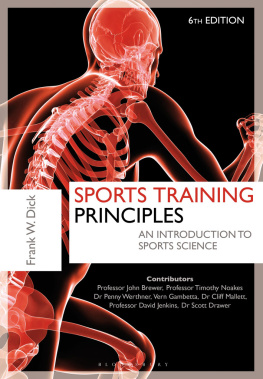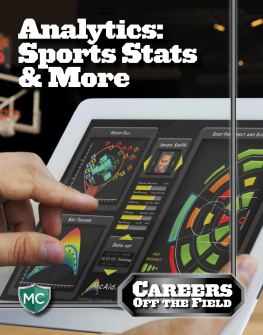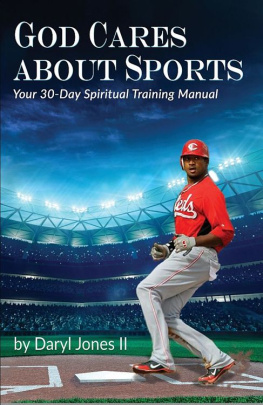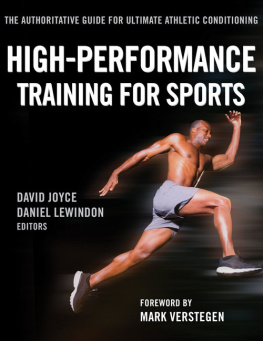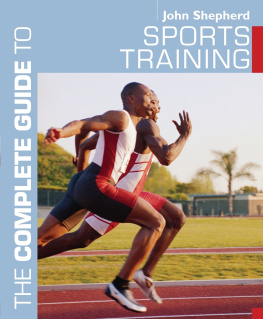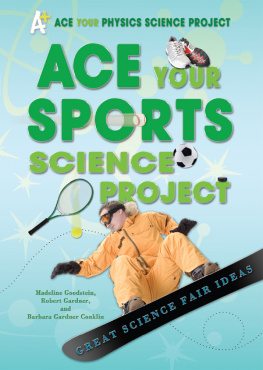Frank W. Dick - Sports Training Principles: An Introduction to Sports Science
Here you can read online Frank W. Dick - Sports Training Principles: An Introduction to Sports Science full text of the book (entire story) in english for free. Download pdf and epub, get meaning, cover and reviews about this ebook. year: 2015, publisher: Bloomsbury Sport, genre: Science. Description of the work, (preface) as well as reviews are available. Best literature library LitArk.com created for fans of good reading and offers a wide selection of genres:
Romance novel
Science fiction
Adventure
Detective
Science
History
Home and family
Prose
Art
Politics
Computer
Non-fiction
Religion
Business
Children
Humor
Choose a favorite category and find really read worthwhile books. Enjoy immersion in the world of imagination, feel the emotions of the characters or learn something new for yourself, make an fascinating discovery.
- Book:Sports Training Principles: An Introduction to Sports Science
- Author:
- Publisher:Bloomsbury Sport
- Genre:
- Year:2015
- Rating:5 / 5
- Favourites:Add to favourites
- Your mark:
- 100
- 1
- 2
- 3
- 4
- 5
Sports Training Principles: An Introduction to Sports Science: summary, description and annotation
We offer to read an annotation, description, summary or preface (depends on what the author of the book "Sports Training Principles: An Introduction to Sports Science" wrote himself). If you haven't found the necessary information about the book — write in the comments, we will try to find it.
Frank W. Dick: author's other books
Who wrote Sports Training Principles: An Introduction to Sports Science? Find out the surname, the name of the author of the book and a list of all author's works by series.
Sports Training Principles: An Introduction to Sports Science — read online for free the complete book (whole text) full work
Below is the text of the book, divided by pages. System saving the place of the last page read, allows you to conveniently read the book "Sports Training Principles: An Introduction to Sports Science" online for free, without having to search again every time where you left off. Put a bookmark, and you can go to the page where you finished reading at any time.
Font size:
Interval:
Bookmark:


Note: While every effort has been made to ensure that the content of this book is as technically accurate and as sound as possible, neither the author nor the publishers can accept responsibility for any injury or loss sustained as a result of the use of this material.
Published by Bloomsbury Publishing Plc
50 Bedford Square
London WC1B 3DP
www.bloomsbury.com
Bloomsbury is a trademark of Bloomsbury Publishing Plc
This electronic edition published in 2014 by Bloomsbury Publishing Plc
Sixth edition 2014, Fifth edition 2007, Fourth edition 2002, Third edition 1997,
Second edition 1989, First edition published in 1980 by Lepus Books,
an imprint of Henry Kimpton (Publishers) Ltd
Copyright 1980, 1989, 1997, 2002, 2007, 2014 Frank W. Dick
ISBN (epub): 9781472905284
All rights reserved
You may not copy, distribute, transmit, reproduce or otherwise make available this publication (or any part of it) in any form, or by any means (including without limitation electronic, digital, optical, mechanical, photocopying, printing, recording or otherwise), without the prior written permission of the publisher. Any person who does any unauthorised act in relation to this publication may be liable to criminal prosecution and civil claims for damages
Frank W. Dick has asserted his rights under the Copyright, Design and Patents Act, 1988, to be identified as the author of this work.
A CIP catalogue record for this book is available from the British Library.
Acknowledgements
Cover photograph Shutterstock
Inside photo credits are as per the print edition: All inside images
Illustrations by Dave Saunders and Dave Gardner
Commissioning Editor: Kirsty Schaper
Editor: Sarah Cole
To find out more about our authors and their books please visit www.bloomsbury.com where you will find extracts, author interviews and details of forthcoming events, and to be the first to hear about latest releases and special offers, sign up for our newsletters here.
It has always fascinated me that athletes are able to produce almost identical times over their racing distance, yet their training plans seem extremely diverse. This fascination naturally led me to enquiry, and I began with a study of the relevant aspects of anatomy, physiology and psychology.
In presenting my interpretation of these aspects, I wish to acknowledge, with both respect and gratitude, the counsel of several authorities. Dr H. Robson (Loughborough University) and Dr Siggerseth (University of Oregon), who were my lecturers in anatomy and kinesiology. Tom Craig (formerly physiotherapist to Glasgow Rangers Football Club), who wrapped much meat around the bones of . Bridging anatomy, physiology and psychology is the theme of applying each science to the growing child, a concept made much clearer for me by Dr Ivan Szmodis (Central School of Sports, Budapest).
The sciences of anatomy, physiology and psychology are essential basics in pursuing this enquiry, but are as far from being an explanation as bricks are to being a house. might then be thought of as the cement, giving these bricks context.So many associates have helped me in this area of study that it would be impossible for me to list them all here. However, I would like to record my deep indebtedness to them and to mention especially: Dr Geoff Gowan, Basil Stamatakis, Tony Chapman, Ron Pickering, Wilf Paish, Friedhelm Endemann, Stewart Togher, Vladimir Kuznyetsov, Peter Radford, Sandy Ewen, Gerard Mach, Carlo Vittori, Wilson Young, Gordon Forster, Denis Watts, Harry Wilson, Alex Naylor, Bill Bowerman, Dr Elio Locatelli, Seppo Nutilla, Peter Coe, Max Jones, Carlton Johnson, John Issacs, Erkki Oikarinen, Rita Englebrecht, Dr Ekkart Arbeit, and Norman Brooke for their thoughts and comments on strength, speed, mobility and endurance.
It would be very difficult to say exactly when I first began to draw together the detail of the final part of this book whenever it was will coincide with the origins of that fascination referred to earlier. I see as the design or blueprint, and it is my opinion that every coach I have ever met (from several sports) is responsible for its content.
It has also become very clear to me that central to the education and development of any coach is what he can learn from the athletes themselves. I owe each one of the athletes I have coached an immense debt in this respect.
Although the book began to grow several years before pen was put to paper in the autumn of 1975 for the first edition, the nature of its contents means the subject matter requires regular review. The second edition did, in fact, consider again certain aspects of strength, speed and endurance training, and, in particular, focused more tightly on the area of regeneration in the Training v straining chapter.
In the third edition, three colleagues contributed their specialist knowledge to take the components of training theory, as set out here, to a new level. Dr Craig Sharp (West London Institute) reviewed and edited . I am very grateful for their continued professional and authoritative input.
In the fourth and fifth editions I enhanced the content relating to process in , with the help of Andy Roxborough (UEFA Technical Director), Josef Vengelos (UEFA), Ian McGeechan (former Chief Coach Scotland RU), Dr Ekkart Arbeit, Dr Elio Locatelli (IAAF Technical Director), Dr Peter Bonov, Dr Dane Korica, Dr Ron Maughan, Peter Kesne and Dr Wolfgang Ritzdorf. I have also received personal communications from Erkki Oikarrinen (Finland), Peter Tschiene (Germany), Helmar Hommel (Germany), Dr Ekkart Arbeit (Germany), and Elio Locatelli (Italy), and am grateful for their exchange of views.
In the sixth edition I have adopted the same principle as used in the partnership system in coaching. Developments in the performance sciences and in training theory suggest that in these areas, I involve internationally acknowledged experts as co-authors. All have worked with athletes or teams to Olympic and world level while being leaders in their chosen fields of expertise. Sports Training Principles 6th edition is significantly and substantially improved as a consequence and I am deeply grateful to them. Their brief biographies are appended and underline how privileged I am to enjoy their outstanding contributions.
As a student, it was put to me that each one of us is exposed to thousands of facts and opinions and that any ideas we think of as our own are, in fact, simply an interpretation of these facts and opinions. My objective here has been to present my understanding of the principles which may help you establish your presentation of training theory to the advantage of the athletes in your charge. I hope you discover this to be the case.
Throughout this book athletes and coaches are, in the main, referred to individually as he rather than he or she. This has been agreed with the publisher as an expedient only.
Finally, I would like to acknowledge with sincere gratitude, the excellent work of five assistants in typing this text from really bad handwriting! Janet Leyland (1980), Jackie Brown (1989, 1997, 2002), Anna Stanforth (2002), Elvie-Jo Shergold (2007) and Donna Fischetto (2014).
CONTRIBUTORS TO THE SIXTH EDITION
Professor John Brewer,
Professor of Applied Sport Science and Head of the School of Sport, Health and Applied Science at St Marys University, Twickenham, having previously been Professor of Sport at the University of Bedfordshire and Director of Sports Science at GlaxoSmithKline. He also managed the Lilleshall Human Performance Centre for 18 years, where he worked with many of the UKs top sportsmen and women, and was a member of the England backroom staff at two World Cups, 1990 (soccer), and 1992 (cricket). Currently a board member of UK Anti-Doping, and Chair of British Ski and Snowboard, and previously Chair of British Handball during the London 2012 Olympics. He has published papers in peer reviewed journals, and the popular press, and appeared regularly on various media channels providing opinions on sport and exercise science. Married with two daughters, he is a keen skier and has run the London Marathon 15 times.
Font size:
Interval:
Bookmark:
Similar books «Sports Training Principles: An Introduction to Sports Science»
Look at similar books to Sports Training Principles: An Introduction to Sports Science. We have selected literature similar in name and meaning in the hope of providing readers with more options to find new, interesting, not yet read works.
Discussion, reviews of the book Sports Training Principles: An Introduction to Sports Science and just readers' own opinions. Leave your comments, write what you think about the work, its meaning or the main characters. Specify what exactly you liked and what you didn't like, and why you think so.

